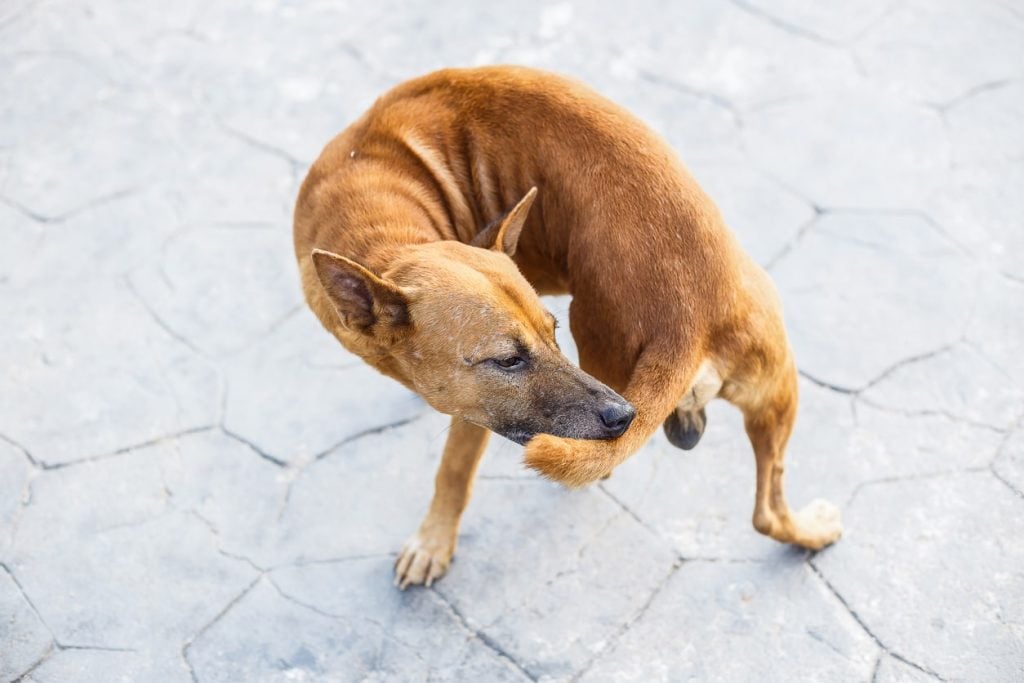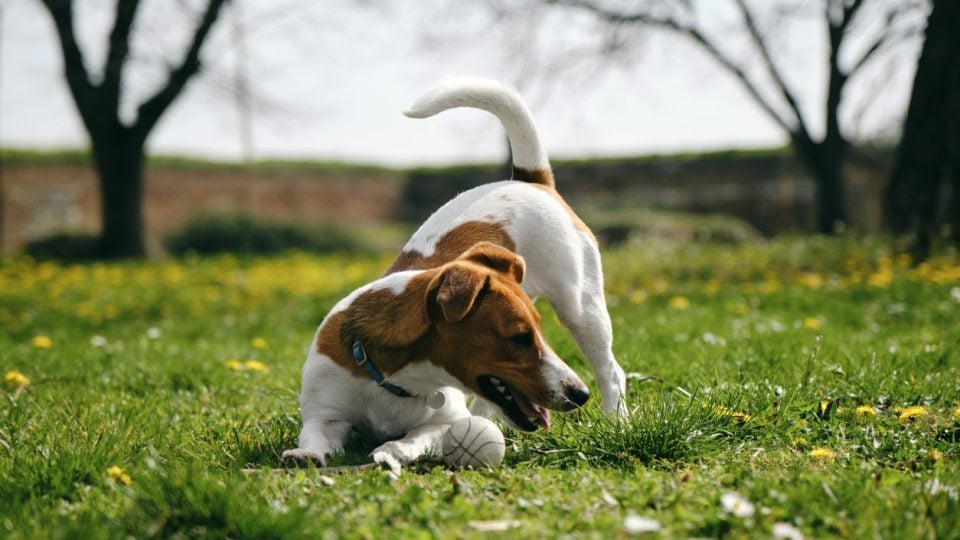Our dogs do all sorts of quirky things, from licking the air to zooming around the house. One behaviour that regularly gets attention is tail chasing.
Dogs chase their tails because they’re playing, bored, stressed, have back pain, skin problems, or even a compulsive disorder, says Dr Maggie O’Brian, a board-certified veterinary behaviourist.
Keep reading to find out why dogs chase their tails and when it’s time to take them to the vet.
1. They’re Playing
Some dogs chase their tails just for fun! This usually happens randomly, only lasts a few seconds, and they can easily stop if something else catches their attention.
Dr Ellen Lindell, a board-certified veterinary behaviourist, says this is especially true for puppies. As puppies grow and find new things to play with, their tails become less interesting, and they usually stop chasing them.
Dr Lindell also says it’s important to keep an eye on your dog’s tail chasing. While it might seem playful at first, it could change and might even be a sign of pain later on.
2. They’re Bored
Dogs can get bored and find different ways to entertain themselves. They need both mental and physical exercise to stay healthy and happy. If they don’t get enough activity, they might chase their tails to have some fun.
While tail chasing caused by boredom isn’t a sign of a health problem, it can mean your dog needs more things to do.
Here are some fun ways to keep your dog entertained:
- puzzle toys
- treat dispensers
- regular play sessions like fetch or tug-of-war
- music
- doggy massages
- battery toys to keep things interesting
Also, taking your dog for an extra walk each day can really help them feel less bored! If you’re too busy, you can find a trusted dog walker nearby to help out.
3. They’re Anxious or Stressed
Sometimes, dogs can feel anxious or stressed, making them chase their tails. When dogs are stressed, they might try different behaviours to feel better.
Dr Lindell explains that tail chasing can be what’s called a ‘displacement behaviour’. This means that when a dog feels frustrated and can’t get what they want, they might start chasing their tail instead.
Other displacement behaviours you might see include:
Dogs often show these behaviours when they are waiting:
- for their dinner
- to go for a walk
- for their turn in training
- for someone they love to come home
If you notice your dog only chases their tail in certain situations, teaching them a better way to cope is a good idea. You can train them to ‘lie down and wait’ or to ‘get a toy and sit.’
4. They Have a Compulsive Disorder
Sometimes, dogs can develop a behaviour that they can’t control. Dr Lindell explains that it is considered compulsive when a dog keeps doing a behaviour without a clear reason and can’t be distracted.
Dr O’Brian points out some signs that a dog might be compulsively chasing their tail if they’re:
- chasing their tail for significant portions of the day
- having difficulty redirecting their behaviour to a different one
- tail chasing without an identifiable trigger
If you’re worried that your dog’s tail chasing is getting out of control and affecting their happiness, it’s very important to talk to your veterinarian for help.
5. They Have a Medical Problem
Even though it’s rare, tail chasing could mean something is wrong with your dog.
Dr O’Brian says some health problems that make dogs chase their tails include:
- Nerve pain. This happens when your dog’s nerves aren’t working right or are hurt.
- Muscle or bone pain. If your dog’s muscles, bones, or ligaments in their tail hurt, they might chase their tail to try to feel better.
- Skin problems. Dogs may chase their tails if they have allergies, fleas, or fungal infections that make them itchy or uncomfortable.
If you think your dog is chasing their tail because of a health problem, look for these signs:
- excessive licking or biting their tail too much
- redness, swelling, or sores near their tail
- losing fur around the base of their tail
- showing pain when you touch their tail
It’s a good idea to take your dog to the vet to make sure there’s no health issue causing the tail chasing.
Do Certain Breeds Chase Their Tails More Often?
Dr O’Brian explains that while pain can make any dog chase their tail, it’s especially important to consider it in breeds more likely to have back pain or other health problems, like German Shepherds.
She also says that some dog breeds are known to chase their tails more often, including:
- Staffordshire Bull Terriers
- Australian Cattle Dogs
Studies have even shown that neutered females are less likely to chase their tails, and tail chasers tend to be shyer.

iStock/Zania Studio
How Can I Stop My Dog From Chasing Their Tail?
To help stop your dog from chasing their tail, it’s important to understand their body language. This can help you tell if they’re playing (with a happy face) or if something is wrong (with a stiff body).
If your dog looks unhappy after chasing their tail or if they do it more often, it’s a good idea to take them to the vet to check for any health problems.
Dr Lindell says that sometimes, people might accidentally encourage tail chasing by watching, clapping, or laughing. She advises that if the behaviour is not too serious, it’s better to ignore it or gently guide your dog to do something else.
If your dog chases their tail because they feel frustrated or anxious, you can help them feel better by:
- Creating a daily routine: this gives your dog stability and makes them feel secure.
- Giving calming toys or chews: these can help them relax during stressful times.
- Providing a quiet, safe space: this is a place where your dog can go to feel calm.
When to Worry About Your Dog’s Tail Chasing
If your dog only chases their tail sometimes, there’s usually no need to worry. But if it happens often or you see signs of pain, it’s time to visit the vet.
Dr Lindell says that if a dog is compulsively chasing their tail—meaning they can’t stop and there’s no clear reason—they should get a full check-up to see what’s happening.
She also explains that if your dog is hurting themselves, it’s really important to determine if a health issue or behaviour problem is causing it. A behavioural assessment can help determine what’s making your dog anxious or frustrated.



